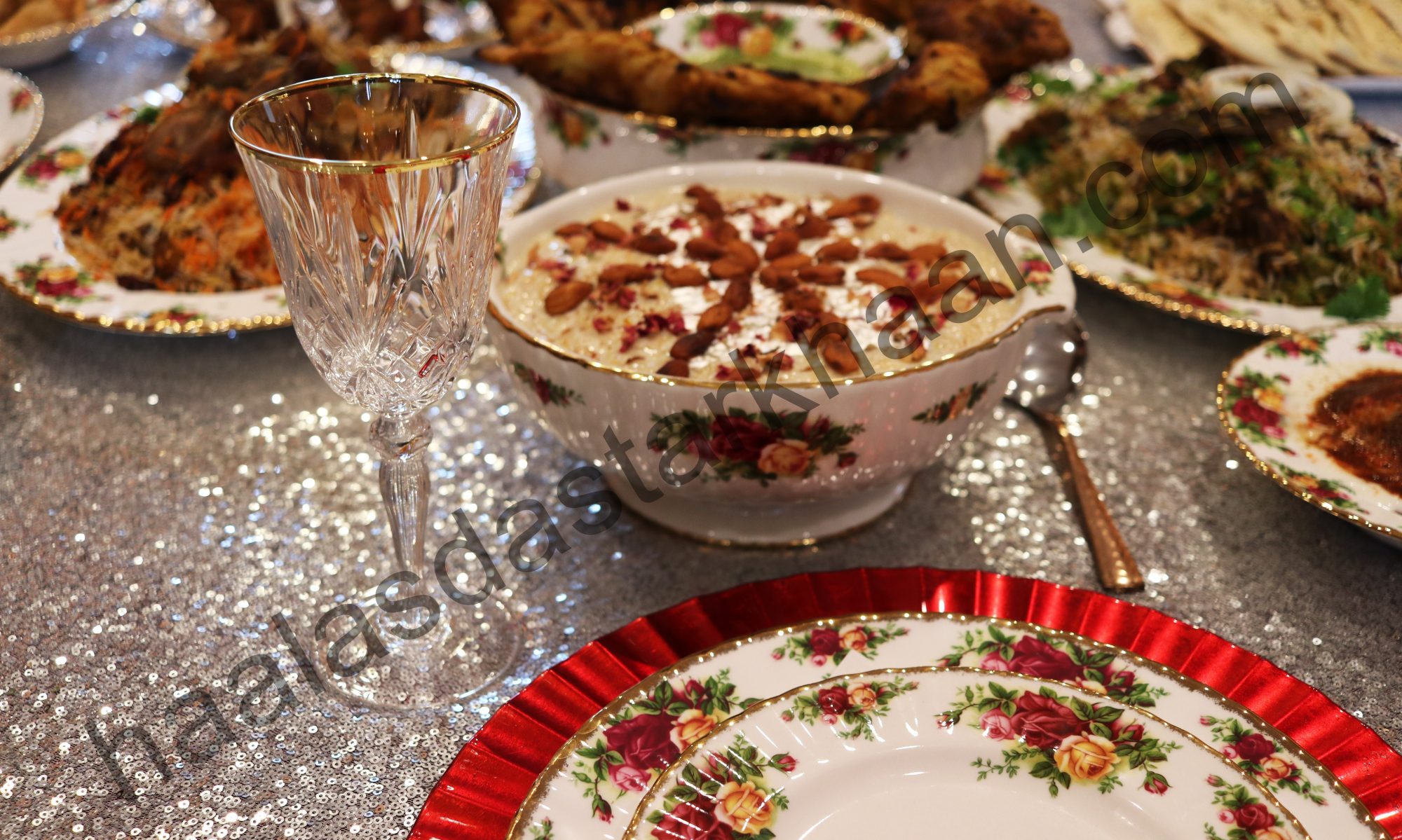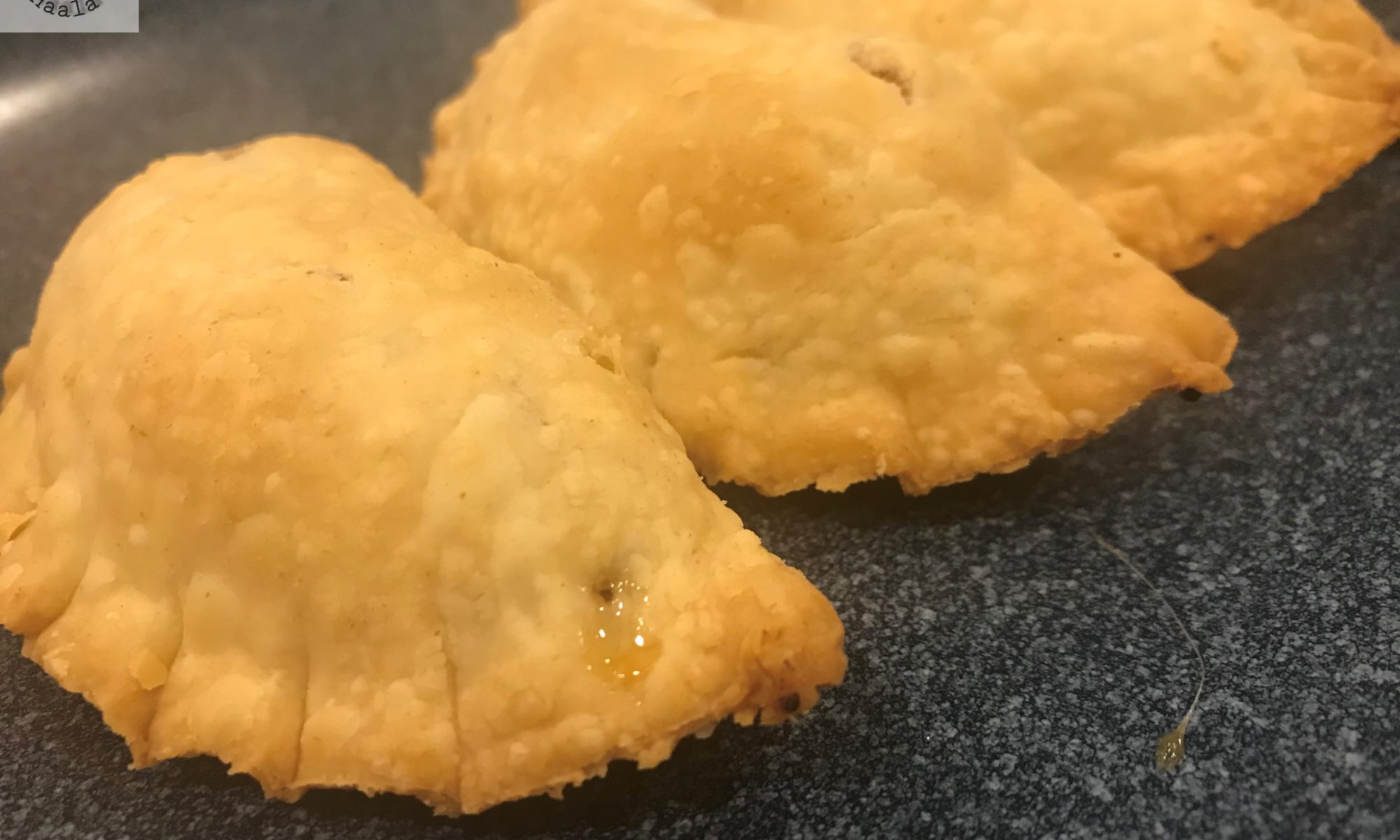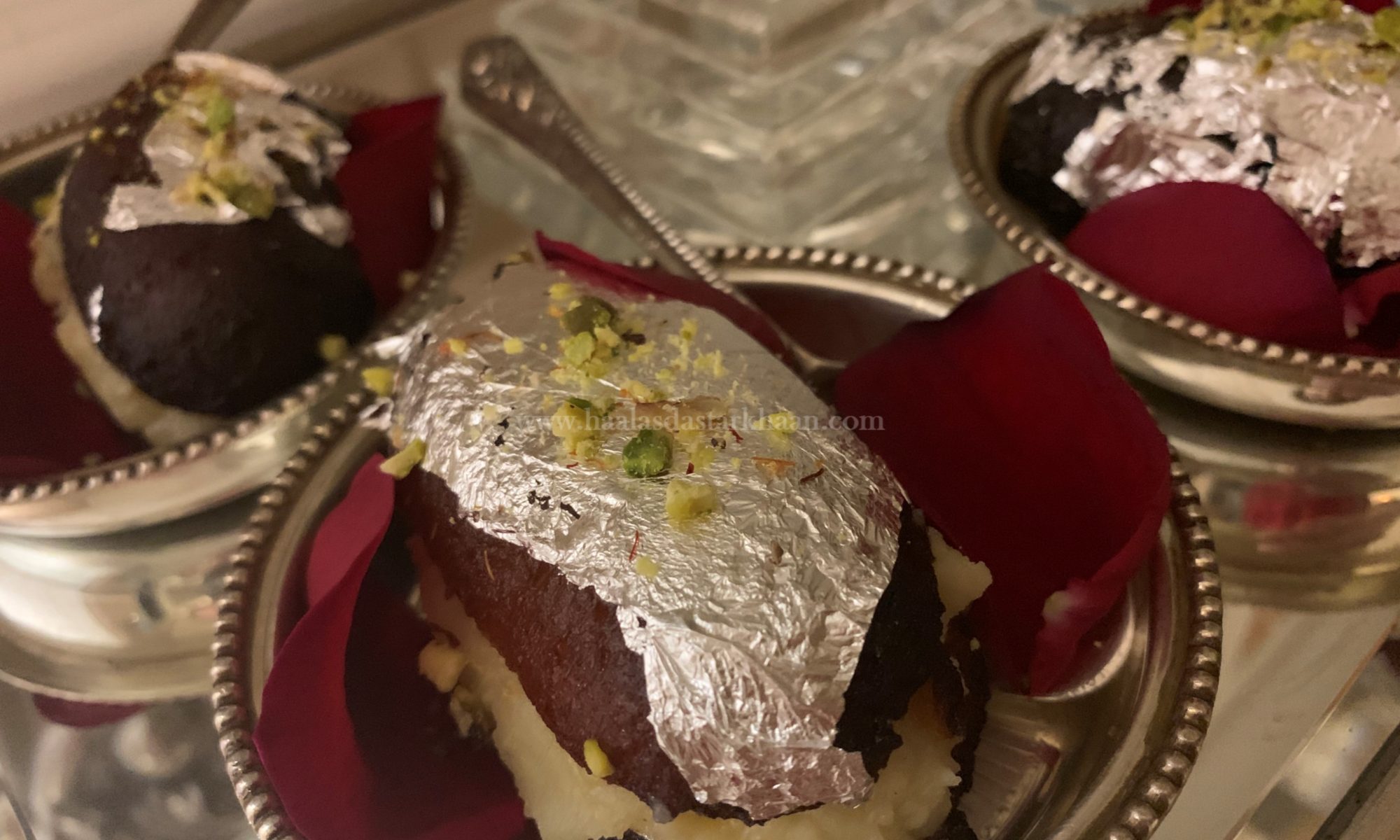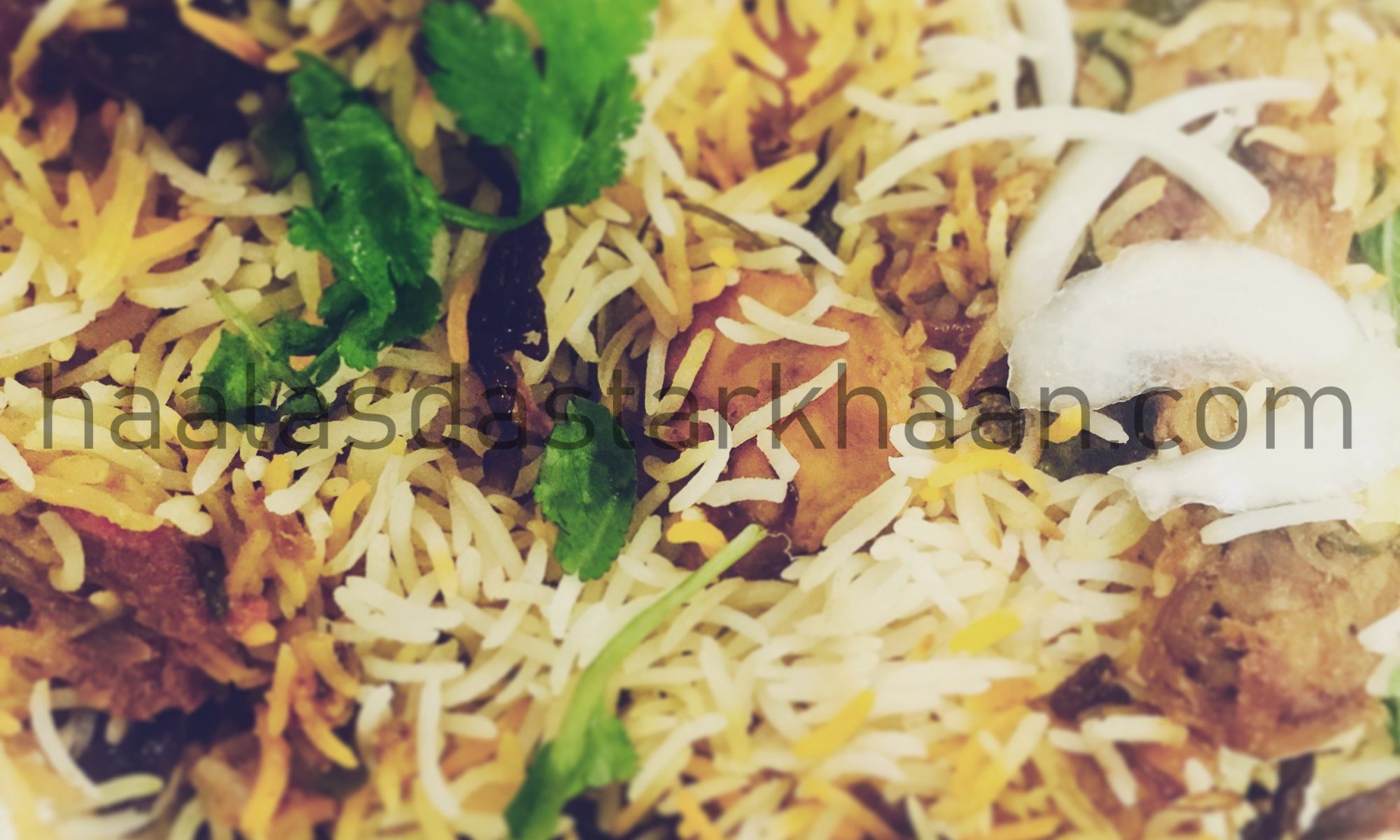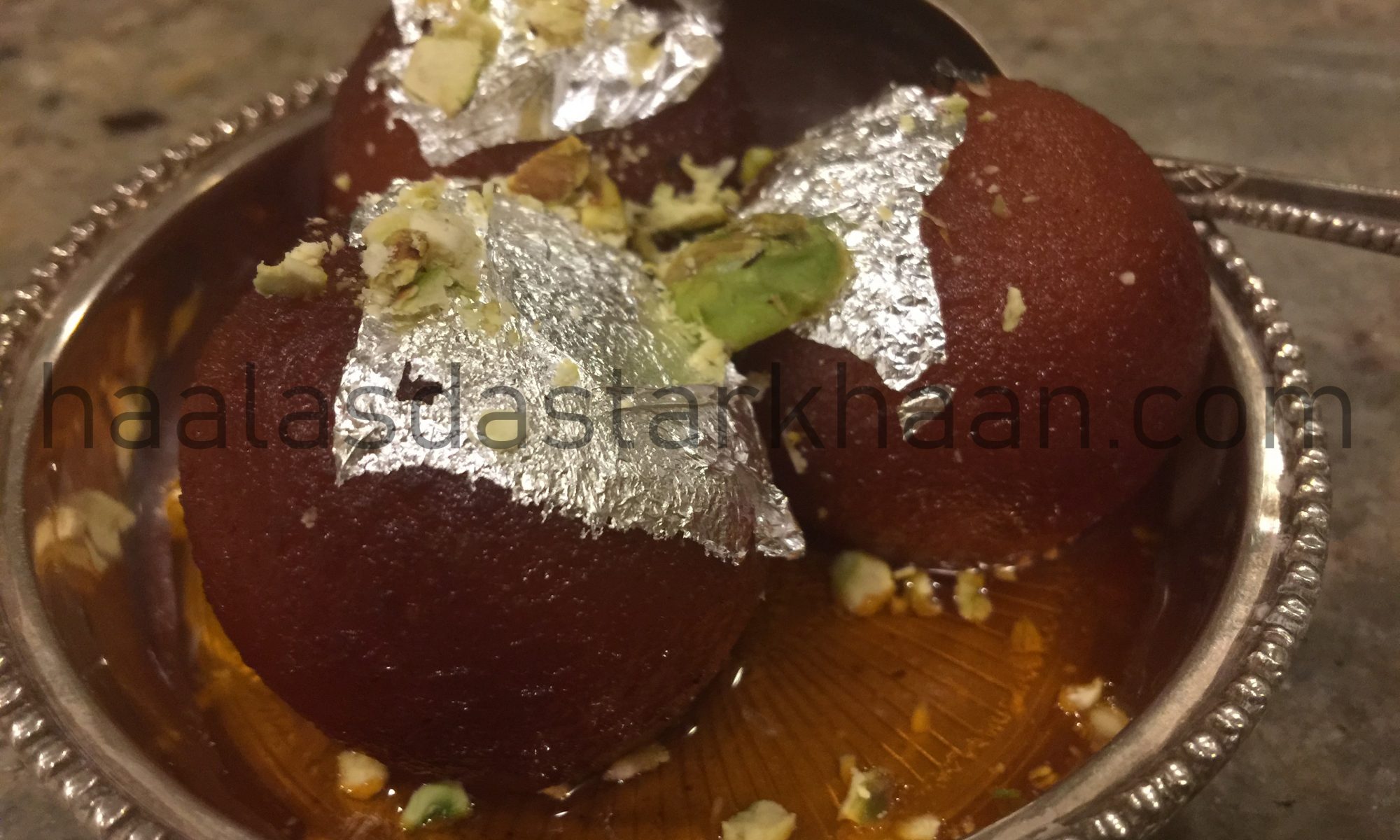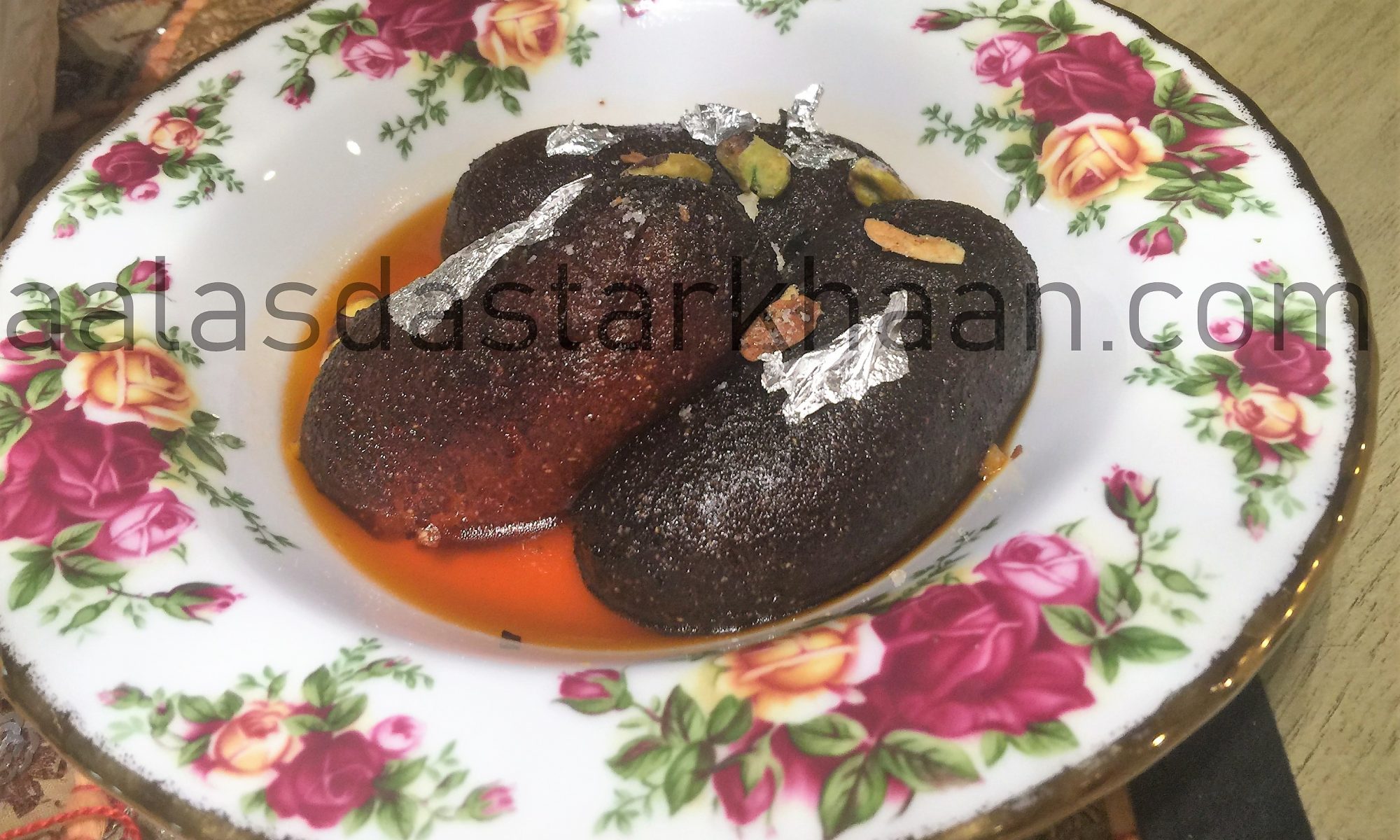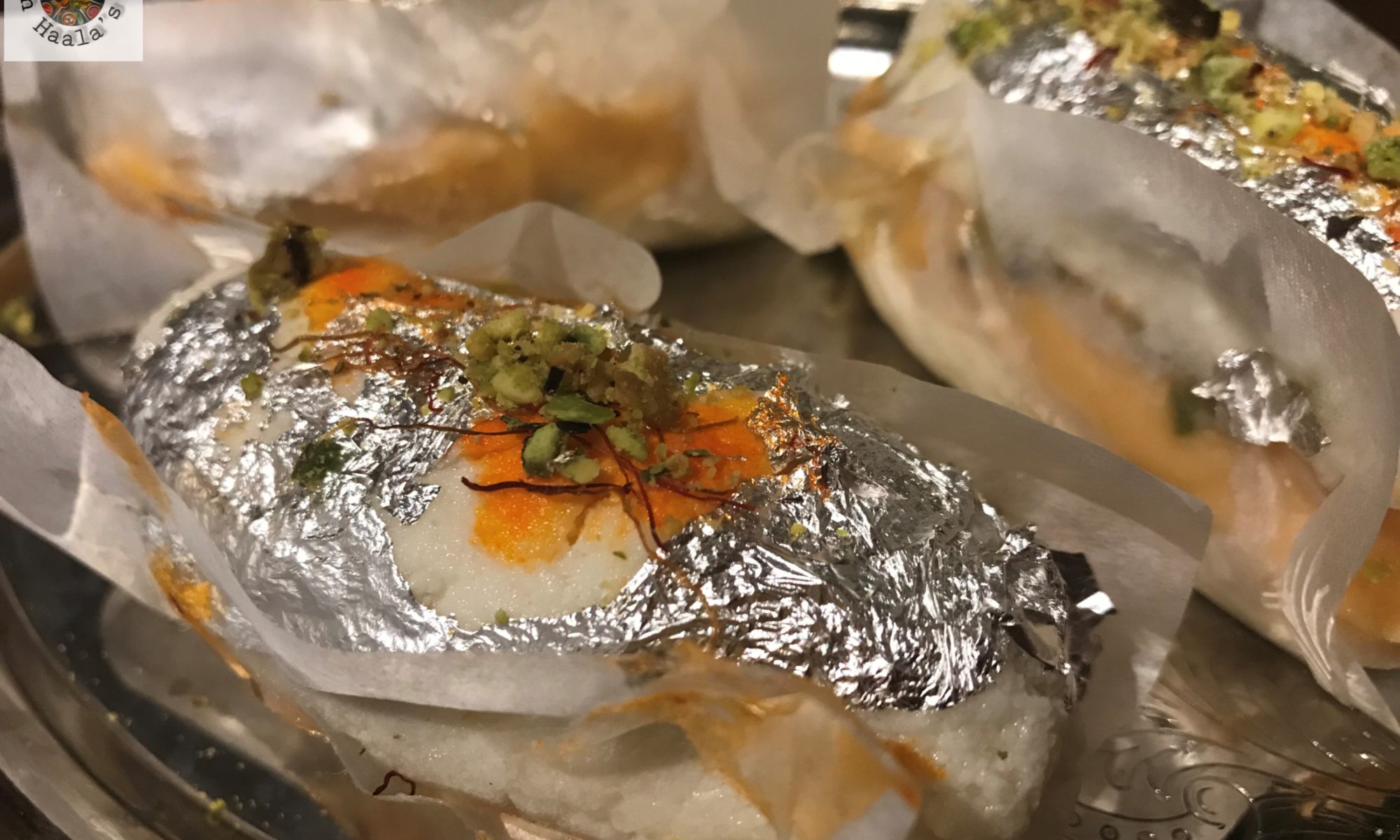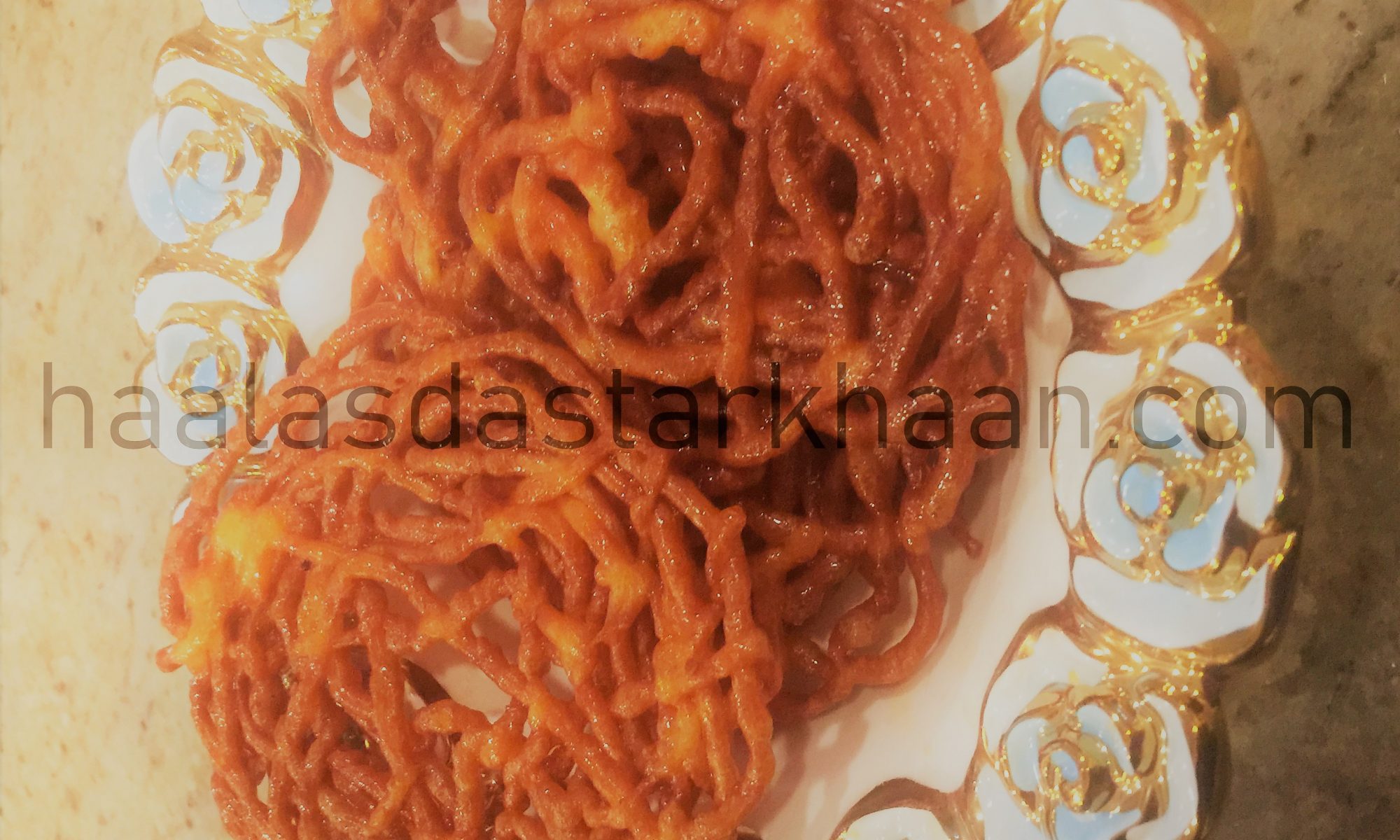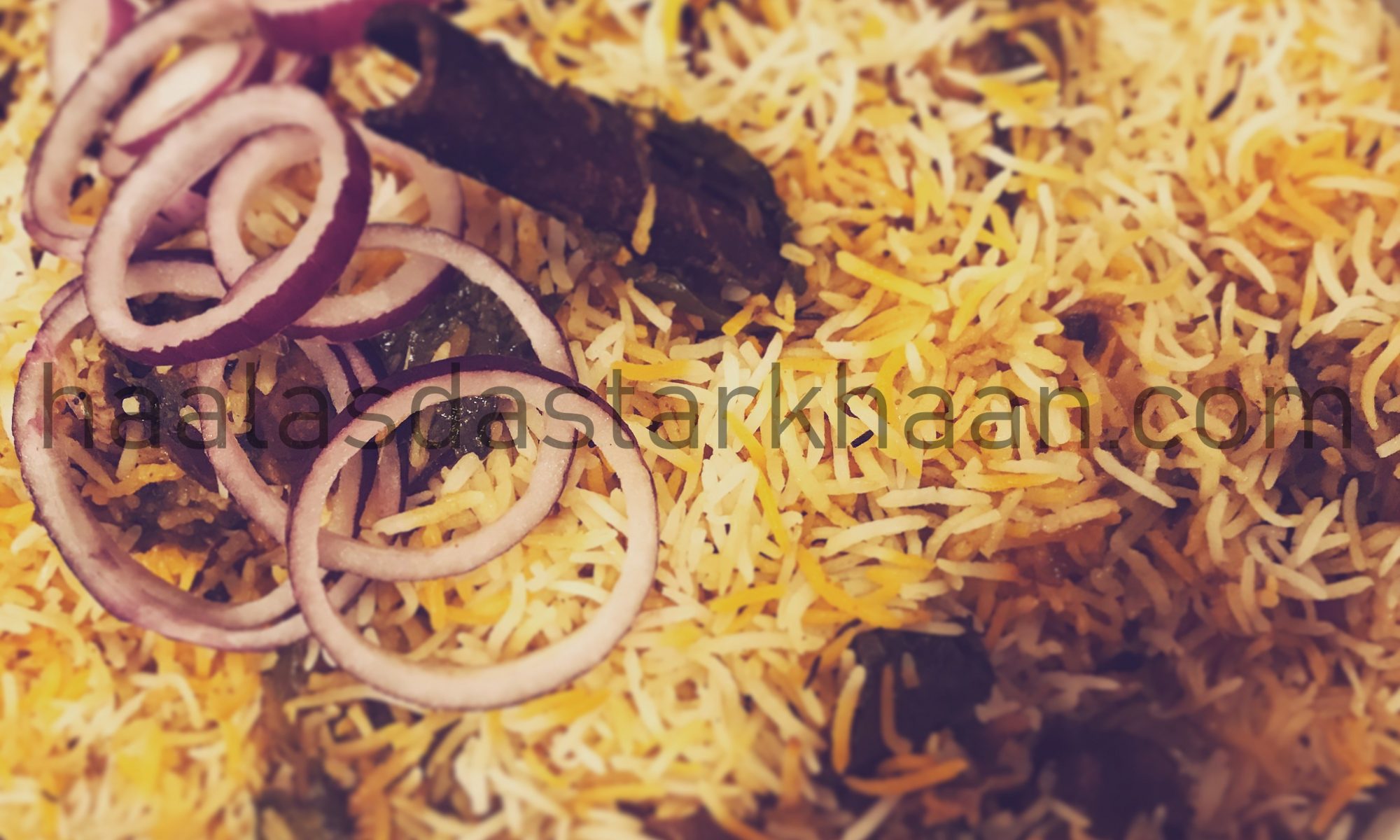Gulab Jamun Sandwich
Gulab Jamun are the “go to” sweet dish for every home in India. Popular, Likeable, or should I say lovable by every soul. And, if you love Gulab Jamuns, then a Gulab Jamun Sandwich just comes in as something fancier and nicer.
Though Gulab Jamuns aren’t referred to as Bengali sweets, but I think the variation has nothing to do with Bengal. Gulab Jamun sandwich is a milk solid based rich sweet from the Indian subcontinent, very popular in India, Nepal, Pakistan. In Maldives they call it Gulab Jaanu Sandwich, and in Bangladesh, its called Gulaab Jaam Sandwich.
It is made mainly from milk solids, traditionally from Khoya, which is milk reduced to the consistency of a soft dough. Mixing in butter, flour, and milk/yogurt with the soft Khoya and form cylindrical balls, deep fry and add them to the sugar syrup. The sugar syrup is made of sugar, water, saffron, cardamom powder and rose water. Modern recipes call for dried/powdered milk instead of Khoya, which is fine as well. The middle part is made of Khoya and granulated sugar. You can always add a few saffron stands and screw pine water for enhancing flavors. It is often garnished with dried nuts such as crushed pistachios and almonds to enhance flavor.
For preparing this it is necessary to give cylindrical shape to the classic or traditional Gulab Jamun and fill it with extra khoya in between. You don’t really need that little mix pack or run to the store to have these perfect, rich delights at home. Making Gulab Jamun Sandwich at home, with ingredients you will find at home, is pretty easy and not at all time consuming. The only thing you need is a perfect recipe.
Now, if you ever thought Gulab Jamun Sandwich is a gift of India to the world, you are wrong. Gulab Jamuns are actually a gift from the Mughals. All these sweet dishes that used Orange Blossom water or Rose water or screw pine water with saffron are all delicacies that came in from the Middle East and were introduced to Indian cuisine during the Mughal Era.
As the history says, the Gulab Jamuns were first prepared in the era of medieval times in India, derived from a sweet fritter recipe that a Central Asian Turkish invader brought to India. One theory also claims that it was accidentally prepared by the Mughal emperor Shah Jahan’s personal chef. All in all, it is a sweet dish inspired by the Middle east.
The word “Gulab” is derived from the Persian words gul, which means flower and āb, means water, referring to the rose water-scented syrup. Jamun is also defined as a fried delicacy in dipped in sugar syrup. A middle eastern dessert Luqmat al-qadi is very similar to gulab jamun, though it uses a different batter. Gulaab jamun Sandwich must be a variation tried by the Mughal Emperors as well, since the era has its own tales of rich food, made from Milk, saffron and dry fruits. And, I believe if a community can make use of milk solids to cook their non vegetarian dishes, they can definitely do a lot with their vegetarian sweet dish.
These outstanding Gulab Jamun Sandwich have a remarkable depth of taste and texture, achieved very carefully combining few ingredients to form cylindrical balls. Fry them slowly in ghee or oil, further soak them in syrup, Cut them from the middle and fill the middle part with Khoya filling. Decorate with a silver leaf and crushed nuts. Serve and amaze. With such detailed recipe, its hard to go wrong.
Malabar Chicken Biryani
Malabar food is a Biryani dish from Kerela. The famous dish is made by layering aromatic Rice with chicken masala, mostly made in Ghee. The recipe demands the pot to be sealed with flour or tight cloth, after the Rice and chicken are layered and Biryani is set to dumm. It should be cooked on low heat to get the perfect Biryani that has been one of Kerela’s most popular and beautiful recipes.
The great town Calicut, now known has Kozhikode is known for its amazing cuisines along with beautiful beaches. The place has had many settlers and the cuisines show an influence of the the travelers from different countries that had once been the part of Calicut’s gorgeous history. Biryani of course shows a clear influence of Persin / Mughal era. the local cuisine is known for its sumptuous non vegetarian food and Chicken Biryani seems to be one of the top favorites.
Coming back to today’s recipe for Malabar Biryani, its usually made with Chicken, but I am sure the recipe would work great on Meat and Fish too, though you might want to change the proportion of spices. The Malabari call the cooking of this Biryani to be a “Pakki method” in which Rice and chicken are cooked separately and then layered and put to dumm.
Malabar Biryani is usually cooked in Ghee. The liberal use of ghee along side of whole spices, like Cinnamon, cloves, cardamom and star anise make an awesomely fragrant dish. I am not a big fan of cooking the whole Biryani in Ghee, so I have been slightly careful. But you can always substitute Oil for Ghee if it suits your taste buds. This dish is spicy, but not spicy enough to make you cry. So, if you like Biryani, but aren’t a fan of Indian food that’s “hot”, this dish is for you.
Malabar Biryani uses Khaima Rice and I tried to look for a good quality Khaima Rice in United States. Since my search didn’t give me any results, I am sticking to my original long grained Basmati Rice. My Mother in law loves her Biryani cooked with Jeerakasala Rice, which is close or same as Khaima Rice. So, if you do happen to find a good brand, Please use it and also let me know in the comment section. The extra water in the Rice is drained and the rice is cooled slightly. Unlike the absorption method of cooking, this method of cooking rice in an open pan in excess water and draining it like pasta will always give you perfect Rice thats needed for a good Biryani.
The chicken is first cooked in onions, ginger, garlic, fresh cilantro, mint and green chilies and yogurt. Tomatoes can or cannot be used. I saw different recipes and I preferred the one with tomatoes. Once the chicken is all cooked, layer it with the Rice and seal the Biryani with a cloth and a tight lid. Adding some kind of weight to the lid is advisable too. I usually keep my Biryani in the oven but you can always dumm it on the gas at low flame for around 30 minutes.
Gulab Jamun
Every time someone mentions these awesome, sweet, sugary balls, people either tend to get them from a sweet store or if they are home made, most times they are made from the popular mix pack that has you add a few easy ingredients from home, like sugar and milk and fry them and you all set to serve them. But, little do you know that you don’t really need that little pack or run to the store. Making Gulab Jamuns at home, with ingredients you will find at home, is pretty easy and not at all time consuming. The only thing you need is a perfect recipe.
Now, if you ever thought Gulab Jamuns is a gift of India to the world, you are wrong. Gulab Jamuns are actually a gift from the Mughals. All these sweet dishes that used Orange Blossom water or Rose water or screw pine water with saffron are all delicacies that came in from the Middle East and were introduced to Indian cuisine during the Mughal Era.
As the history says, the Gulab Jamuns were first prepared in the era of medieval times in India, derived from a sweet fritter recipe that a Central Asian Turkish invader brought to India. One theory also claims that it was accidentally prepared by the Mughal emperor Shah Jahan’s personal chef. All in all, it is a sweet dish inspired by the Middle east.
The word “Gulab” is derived from the Persian words gul, which means flower and āb, means water, referring to the rose water-scented syrup. Jamun is also defined as a fried delicacy in dipped in sugar syrup. A middle eastern dessert Luqmat al-qadi is very similar to gulab jamun, though it uses a different batter.
These outstanding Gulab Jamuns have a remarkable depth of taste and texture achieved very carefully combining few ingredients to form balls. Fry them slowly in ghee or oil, further soak them in syrup. With such detailed recipe, its hard to go wrong.
Mewa Baati
If you like Gulab Jamuns, you will definitely like these. These are almost the same recipe as Khoya Gulab Jamun with a filling of dry fruits inside. Change the shape to make it look different from regular Gulab Jamuns. I made them oblong, you can always make them bigger and round if that appeals you more.
Malai Chum Chum
Bengali sweets happen to be one of the best sweets in India. They offer a wide variety from Rasgullas to Mishti Doi and most people who like Indian sweets always love these sweet sugar dipped treats.
Malai Chum Chum is a very popular Bengali sweet made with Paneer or homemade Cottage Cheese. It is a delicious Indian dessert that cannot be resisted since they are amazingly delicious to look at and delectable. These chum chums are soaked in sugar syrup and in between are filled with rich and creamy Khoya filling.
Mr. Parveez loves Malai Chumchum and he would always buy them from his favorite Indian sweet shop here. There were few other ones as well and he loved them all. Few years back we moved houses and we went pretty far from the area of our favorite Indian area. So, the visits to the sweet shop weren’t as frequent and Mr. Parveez though deprived never complained and neither did he ever ask me to try.
Actually there is a funny story to him asking too. As a newly married wife, every now and then I would try to make dishes that we have tried at different restaurants. I still don’t know why I did that, probably just wanted to amaze my husband …LOLzzz. But instead of impressing him, he asked me to stop. The problem was that making the dishes we eat at restaurant would be close to what we eat outside, but the charm of enjoying a meal outside would be lost. So, as much as I wanted to try making some of these sweets, I would not attempt and just get the sweets from the sweets store whenever we would be in that area. Few years ago we moved to our new house, and the house is pretty far for us to visit that sweet store as often as we would like to, and the closest Indian market does not sell sweets of the same quality unless we buy frozen and we all know frozen loses the taste.
And that’s how I decided to make my own. Initially when I started making Rasgullas because that makes a base for all the bengali sweets, or most of them. The Rasgullas need a little tactic that makes sure they are spongy and can absorb the sweetness from the sugar syrup. That’s the first thing you need to master and as easy as the recipe looks and seems, they aren’t that easy. It took me around 5 trials to master them.
For Malai Chumchum, make rasgullas and once done have to be cut into half and add khoya mix . The middle part is khoya mixed with sugar and a little spice to enhance flavors. You can always a little bit of food color to make the dish look nicer. Garnish with silver leaf and crushed nuts.
You can always make them 4-5 days in advance. Refrigerate and serve chilled.
Maave Ki Kachori
Jodhpur, my beautiful hometown and land of sweetness and colorful people. One of the most popular sweet is Maave ki Kachori. The crunchy outer crust and slightly sweet inside dipped in the sugar syrup.
For Mr. Parveez it was love at first sight or love at first bite. He enjoyed it so much that every Jodhpur visit, Maave Ki Kachori was a must and if we had any one coming over, we would ask them to get it for us, which I would fry again and pour some warm sugar syrup on it ans serve. As much as we would appreciate the pain people would go through to bring/send these awesome sweets to us, but the only problem was that staying without refrigeration for so long would spoil the taste a little and we wouldn’t be able to enjoy more that 25%. So, with time, we had to give up on that.
The best Maava Kachori according the polls is made by Raawat sweet store and I once happened to have a few guests over , out of which one has been to Jodhpur and has tried maava Kachori from that sweet store. I was truly honored when the guest told me that mine would win if there was a competition. Its always great to receive compliments from my boys and as much as I know that they are honest when it comes to food, I still believe they appreciate my efforts at times and never complain if the dish hasn’t come out great.
And then finally one day I decided to try my own. Before I write the whole recipe, let me tell you this…I have never eaten or tried Maave Ki Kachori. I am just few of those “weirdos” who do not enjoy sweets made with sugar syrup and therefore when the thought came to my mind, it was actually an arrow in the dark. What I knew was that the filling has Khoya and nuts and slight taste of some spices. The biggest blessing is to have a husband who has amazing taste buds and therefore, it was easy to have him try the filling before I finalize it.
The first attempt had too much spice and it was hard to taste the khoya and sweetness. The second try had too little spice. The third one was perfect since I understood how and what to do. The khoya needs to have a little bit of clove but suggest that they shouldn’t be powdered and they should be mixed as is in the pan while cooking khoya and should be taken out leaving the flavor. Besides, cloves, its cardamom powder, cinnamon powder and Nutmeg powder.
When you start cooking the Khoya would melt in the pan and that’s good since it makes it easier to blend it with flavor of spices, and when it cools down, it automatically solidifies again. Sugar should be mixed only once its taken off the pan.
Jalebi
Indian word jalebi is derived from the Arabic word zulabiya or the Persian zolbiya, another name for Luqmat al Qadi. This recipe was brought to Medieval India by Persian-speaking Turkish invaders. In 15th century India, jalebi was known as Kundalika or Jalavallika. The versions kept changing and ultimately the Mughals made it “Jalebi”, the way we all enjoy it today.
There is no Indian/ Pakistani/Bangladeshi I met who haven’t shown their love for Jalebis to me. Its heavenly, crispy, sweet and melts your heart. My hometown, Jodhpur makes the best Jalebis in this world. If you don’t believe me, take a trip to the most gorgeous city of Rajasthan, land of the last palace built in India and the land to Rao Jodhana, “Jodhpur”.
Its a funny connection, but Mr. Parveez’s family hails from the Mughals. We would still like to find details of the connection but for now we only are aware that the family are indirectly the descendants of the Mughlia Dynasty. My husband considers himself the rebirth of one of the Mughal rulers and looking at his taste for food and lifestyle choices and the way he treats the guests, I quiet firmly agree to it…LOLzzz. Since he married me and I am from Jodhpur, he always reminds me of how the Mughal rulers had a crush on women from Marwar. We all know about Maharani Jodha, but the Mughal family had another queen from Marwar and that too from my hometown, Jodhpur. The queen to King Jahangir and Mother to King Shah Jahan was from Jodhpur as well.
Vibrant colors of Jodhpur keep you cool and the warmth of the beautiful people melts your heart. The city where Ghee flows like river and a popular joke among people is that people of Jodhpur are always “Ghee Positive”. Coming back to Jalebis, sweets make morning breakfast in Jodhpur. The most popular breakfast is Doodh Jalebi or Doodh Fini.
When Mr. Parveez and I got married, I knew has a sweet tooth and believe it or not, living in Jodhpur, I cannot eat jalebis. It shocks many, including my better half, but I think I just don’t like any sweets that swim in sugar syrup. Anyways, I told Mr. Parveez during our first visit to Jodhpur after marriage that Doodh Jalebi is a popular breakfast. He thought I was just bluffing and smiled as if he did believe me. To his surprise, that was the first breakfast served to him since everyone knew he likes jalebi and my poor husband thought, “Yeah I do like them but only as dessert and not as the main course. I still remember his face and I still can’t stop laughing at his situation.
Anyways, the jalebi were definitely something to die for, or may be not, but definitely something that would make your trip to Jodhpur very sweet. So, those days, I could have never even thought of trying to make Jalebi at home. Years later, living away from home and seeing 3 men looking for the taste of India in pathetic Jalebi made by the Indian sweet stores here, I decided to venture and make my own.
I never have any leftovers when I make these Jalebi and most of the time they finish in a jiffy when they are fresh. So, if you are making them beforehand, I suggest you make extra. Jalebi are best when consumed fresh. These can stay upto a week, if refrigerated and for 2 days on room temperature.
Mughlai Biryani
This Biryani is very close to my heart. This recipe was shared by Mr. Parveez, some 4 years ago and since then it has been a family favorite. My younger son calls it “Mogli Biryani”, since he feels that Mughlai is very close to”Mogli”, and I am sure somewhere he also believes that this recipe came in from the Jungle book…LOLzzz.
Mr. Parveez came across an article about Mughal migration and food and thats when he learnt that the initial use of spices in Biryani was actually white pepper and not the chilies. Though with time, chilies made a very special place in the Biryani recipes and no Biryani recipe seem to be complete without them, but that wasn’t the way it all started.
Black pepper has a very strong flavor and if you use it often, you would know that using black pepper even little more than required makes the taste of a dish bitter, therefore you need to be careful when handling that spice. Unlike, black pepper, white pepper is easier to handle and does not add bitterness if slightly over used.
This dish has flavors from the Middle east. it isn’t too spicy so it matched perfectly with Mirch ka saalan or Baghare Baingan or khatte Baingan. I have made this for my son’s school party for teachers and it was a big hit. You can use regular chicken cut to medium or small size pieces, though I preferred using chicken legs. It doesn’t change the taste but definitely enhances the look. I have used green chilies, but from the article that I read, it wasn’t a requirement so, the use is optional. Also the garnishing with boiled eggs is completely optional. You can also use cashews, and/or almonds to garnish if you feel like.
Hyderabadi Kacche Gosht Ki Biryani
I came across an article once, which was based on the Nizams of Hyderabad. Hyderabad has witnessed a great variety of food thanks to the Nawabs and Nizams, who ruled Hyderabad at different times. The food was inspired from the Mughlai cuisine, but the additions that the Nawabs made to the cuisine made the dishes outstanding. A result of that is the great contribution of Hyderabad to the food world.
As I have mentioned in a lot of other recipe introductions as well, that Hyderabad has contributed more than a 100 variety of Biryanis, each distinct and equally delicious as the other. And, as much as its hard to understand how they are different, you will either have to cook or try the variety. The spices, the other ingredients and the process of cooking changes the complete flavor of a dish.
Kacche Gosht ki Biryani from Delhi is pretty popular too, but the recipe differs a little. This Biryani is made with partially cooked rice being layered on top of marinated meat which is ‘raw’ and is then ‘dumm cooked’ till the meat and rice come out perfectly cooked. But this dish is still considered to be the ultimate measure of a chef’s skill.
In Olden days, Hyderabad had special Khansamas, who cooked this Biryani in the Nizam’s Bawarchikhaana. Later, these Khansamas were called on special occasions to high class families to bring back the taste of authentic Biryani.
I read that the fine art of making kachche gosht ki biryani is almost lost, as it was becoming surpassed by poorer versions. A classic kachche gosht ki biryani requires patience. Its like a love story, that needs what we call zaaiqaa and mohabbat, and there are still plenty of those emotions in the hearts of Biryani lovers like me.
I believe as the years have passed, people seem to be losing their love for really good, slow food, that is cooked with genuine expertise, and with that they are sadly also losing the taste of authentic food.
Most of these chefs who are still cooking authentic food ended up dying penniless. What a shame for us all, because not only did we lose the art of cooking this dish properly, we also lost a genuine knowledge base and mentoring. But, I believe people like me still exist around the world who are accepting the new quick fixes but, also still cling to the genuine recipes and authentic flavors and love to share and pass along.
Since I do not have the complete authentic Biryani recipe, I did make sure I try and follow the steps and make it as close to the authentic recipe as possible.
